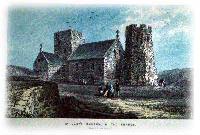St Mary in Castro
This Saxon church was built on the Castle Hill in the 10th century. The church of St Mary in Castro as it stands today is a much restored example of a Saxon church dating from around 1000 AD. It is surrounded by a large late Saxon cemetery which suggests that this church replaces an earlier building.

The church is cruciform in plan, with an aisleless nave and a tower at its centre. It stands on a projecting plinth of plain square section constructed mainly with large stone blocks. The walls are mainly of flint with some stone and tile, and the window facings are mainly tile. The tower is the same width as the nave, but the transepts and chancel are narrower. The arches opening east and west from the tower appear to be original, and are 28 feet high with strip work of projecting tiles outlining the arches on their western faces. The north and south walls of the nave are pierced by unusual double splayed round headed windows. A pair of double splayed flat headed windows near the west end of the side walls of the nave are suggested by Scott to indicate that space was needed for a west gallery. Whilst restoring the church Scott found further evidence of this gallery in the form of holes in the walls for the insertion of supporting timbers. Access to the nave from the south was by way of a tall round headed doorway with through stone facing of alternate upright and flat slabs. This doorway is now blocked and little of its original outlining stripwork remains.
An Early English vault was inserted into the chancel, probably at the end of the twelfth century. In addition the altar recess at the south east corner of the nave probably dates from this period. In 1226 Henry III gave instructions that the church be repaired. In 1247 Henry ordered three altars to be built and dedicated to St. Edmund, St. Adrian and St. Edward. In additon images of these saints and of St. John the Evangelist were to be made. In 1252 three bells were cast at Canterbury to be hung in the tower. The Pharos was used as a bell tower and was connected to the church via a short passage.
At some time between 1324 and 1334 the church was repainted by a painter named John of Maidstone. Two new bells were cast in 1345 at a cost of £15 18s. 5¼d. These weighed 4266 lb. and 1078 lb. In 1494 Sir Edward Poynings, probably acting as deputy to the then Constable, Prince Henry, spent over £36 on the church and keep although the amounts spent on each are not specified.
Between 1555 and 1557 the church was secured as it was about to collapse through want of repair. In 1576 it was recommended that the chancel be repaired in stone, the windows glazed and seats be provided so that men could hear the service. In 1582 fourteen small chairs were finally purchased.
In 1690 public worship in the church ceased although soldiers continued to be buried in the church yard for a time. In 1780 it was converted into a cooperage and storehouse but in 1801 it collapsed, and by 1808 it had become a coal store.
After many years of use as a coal store the church was first restored by Scott between 1860 and 1862, and later by Butterfield in 1888. This later restoration was less sympathetic than Scott's and involved the completion of the tower, the mosaic work in the nave and the building of a vestry.
Saint Mary in Castro was used as the Dover Garrison Church until 2014 and is still a place of worship.
Details of services: www.achurchnearyou.com/st-mary-in-castro-st-mary-in-the-castle-dover-castle